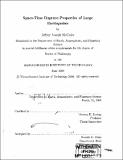Space-time rupture properties of large earthquakes
Author(s)
McGuire, Jeffrey Joseph, 1972-
DownloadFull printable version (13.69Mb)
Other Contributors
Massachusetts Institute of Technology. Dept. of Earth, Atmospheric, and Planetary Sciences.
Advisor
Thomas H. Jordan.
Terms of use
Metadata
Show full item recordAbstract
Slow earthquakes have been hypothesized to be compound events, i.e. comprised of both an ordinary earthquake and a smooth moment-release transient of longer duration. Low-frequency normal-mode based studies which support the compound event hypothesis have suggested that low-frequency source-spectra of some slow earthquakes require that the slow-component initiated before the fast component. We present observations of low-frequency P-wave energy arriving prior to the high-frequency, mainshock for two oceanic transform fault events. Both the 1994, M, 7.0, Romanche and 1997, M, 6.8, Prince Edward Island events show clear time-domain evidence for episodes of smooth moment release that preferentially radiated energy at low frequencies. Inversions for the moment-rate functions of these events yield compound event sequences where the derivative of the moment-rate function is 2-3 orders of magnitude smaller during the slow event than during the ordinary fast event. The smoothness of the moment-rate function implies that the smooth components of the compound events have rupture and slip velocities which are orders of magnitude smaller than those during ordinary earthquakes. Determining the space-time rupture histories of earthquakes that are only recorded teleseismically is a difficult and non-unique process. We developed a method to determine the 2nd degree polynomial moments of an earthquake's space-time moment release distribution using frequency dependent measurements of global surface- and body-wave arrivals. Our method incorporates both current 3-D earth models and the physical constraint that the source-region have non-negative volume. The 2nd moments provide estimates of the duration, spatial extent, and directivity of an event's rupture. In addition, they can be used to systematically resolve the fault-plane ambiguity. Our values of the 2nd moments for the 1995, Mw 8.0, Jalisco Mexico earthquake agree well with those determined from local slip inversions, and our inversion for the 1st-degree moments of the 1995 Kobe earthquake shows that the measurement errors resulting from unmodeled lateral heterogeneity are small. By estimating the 2nd moments for a catalog of large earthquakes, we are able to systematically resolve the fault-plane ambiguity on a global scale. While the 2nd moments of most large earthquakes are aligned along one of the candidate fault-planes of the event's moment tensor, the 2nd moments of the Romanche and Prince Edwards events are oriented at a high angle to both of their candidate fault-planes. The only type of source-model that can satisfy the observed 0th, 1st, and 2nd degree moments of these events is one that involves slip on two parallel faults. This observation agrees with subevent locations determined using travel-time picks which suggest that multiple parallel faults ruptured in both of these earthquakes. The geometry of both event sequences is consistent with a scenario in which a slow-event on the main transform fault redistributes stress in the region, triggering subevents on both the main and sub-parallel adjacent faults. This evidence for co-seismic rupture of multiple faults combined with other seismic and marine geologic data suggest that deformation at oceanic transforms can be distributed over a wide region (~100 km) on both long (geologic) and short (co-seismic) time-scales.
Description
Thesis (Ph.D.)--Massachusetts Institute of Technology, Dept. of Earth, Atmospheric, and Planetary Sciences, 2000. Includes bibliographical references (p. 169-179).
Date issued
2000Department
Massachusetts Institute of Technology. Department of Earth, Atmospheric, and Planetary SciencesPublisher
Massachusetts Institute of Technology
Keywords
Earth, Atmospheric, and Planetary Sciences.